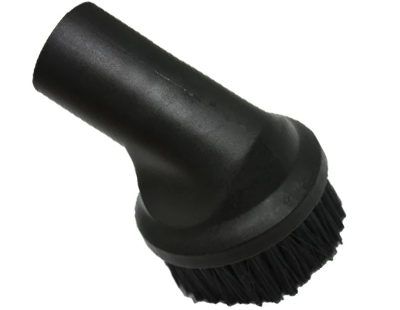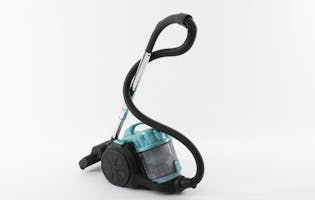How to buy a corded vacuum cleaner
Find the best vacuum cleaner for your home with our buying guide and test results for 36 current and 70 discontinued models.
Looking for a stick vac or robot vac?
Learn how to choose the right vacuum cleaner for your household.
Corded vacuum cleaners are designed for a whole house clean. They’re powered by a mains cable, sit on the floor and have wheels for manoeuvrability. There are upright vacuum cleaner models or compact canister/barrel vacuum cleaners. Dust and debris are stored in a replaceable bag or a bin.

Pros
▲ Provide a good clean on all surface types.
▲ Many vacuum cleaner models come with features such as variable power, adjustable head height, swivel heads and HEPA filters.
▲ Connect to the mains, so no limit on how long you can vacuum for, and suction power is consistent (as long as the bag or bin isn’t full!).
▲ Less expensive to purchase than equivalent cordless stick vacuum cleaners.
▲ Larger capacity for dust and debris compared with cordless stick vacuum cleaners.
Cons
▼ Bulky to store.
▼ Heavier than a cordless stick vacuum cleaner.
▼ More difficult to manoeuvre in tight spaces.
▼ Reach limited to cord length.
Canister vacuum cleaner or upright?
Canister / barrel vacuum cleaners are much more popular than upright vacuum cleaners (around 85% of out tested models are canister). They are easier to manoeuvre and use in small spaces, such as on stairs. Sometimes the main body can get stuck behind objects when you are pulling it along though.
Upright vacuum cleaners require you to push the whole unit around when cleaning. This takes more effort than with a canister model, where the cleaning head is separate from the main body. Upright vacuum cleaners are easier to move from room to room however, as you don’t need to bend to lift them like you do with a barrel vacuum cleaner.
Bag it or Bin it?
Bagless vacuum cleaners are more popular than bagged – nearly 70% of our tested models are bagless. The cheapest vacuum cleaners also tend to be bagless, but as you begin to pay more, you have the option of either.
Bags are going to cost more in the long run with replacements. They also aren’t as environmentally friendly, as you are throwing away a bag every time you fill one. They are more hygienic though, as the dirt, debris and allergens are contained when disposing. Just make sure you have a replacement on hand, or your vacuuming fun will end when the first bag is full.
With a bagless vacuum cleaner, it’s easier to see when the bin needs emptying. Also, if you accidentally vacuum up an important piece of Lego, you will likely be able to find and rescue it. The downside is that bagless vacuum cleaners can be a bit messy to empty, and the bin itself can get dirty and scratched over time.
Vacuum cleaner head types
These are the main head types that come with vacuum cleaners.
Combined carpet and hard-floor vacuum cleaner heads have a setting for both, using only suction to remove dust and debris.

Turbo heads still only use suction but have a rotating brush powered by the suction to help remove more stubborn dirt. They are also better at removing pet hair, although longer hairs can get entwined around the brush. Read our article on how to get hair out of your vacuum cleaner.

Motorised vacuum heads are similar to turbo heads in that they use a rotating brush, but a motor in the head powers the brush. This makes the head more effective at removing hair and stubborn dirt. These vacuum heads aren’t always ideal for hard floors as they can scatter debris, although many have a brush that lowers to combat this. If your home has a lot of hard flooring, consider buying a vacuum cleaner with a dedicated hard-floor head.

Hard-floor tools are unsurprisingly just for hard floors to avoid flicking or just pushing debris around.

Vacuum cleaner accessories
Crevice tool - a long, pointy nozzle for sucking up debris from tight corners or down the sides of furniture.

Upholstery tool - a wider tool used to remove dust from upholstered furniture.

Dusting brush – an attachment with long bristles to help remove dust from furniture, lampshades, blinds, etc without scratching surfaces.

HEPA filters
HEPA stands for ‘high efficiency particulate air’. A HEPA filter can remove at least 99.97% of dust, pollen, mould, bacteria and airborne particles with a size of 0.3 microns (0.003mm). Vacuum cleaners with HEPA filters are a good choice for those who suffer from asthma or have other allergies.
Other things to consider
Reach – this is the length of the cord supplied. It dictates how far from a power socket you can vacuum. This will be important if you have large rooms.
Variable Power – useful if you have thicker carpets that need more suction power at times. But you want to save energy and reduce noise when vacuuming other areas that don’t require as much suction.

Robot vacuum cleaners
Everyone hates vacuum cleaning, so a robot that does it for you must be a good thing, right? Check our robot vacuum cleaner reviews to see if the future is now.
Buying a second-hand vacuum cleaner
Buying a used vacuum cleaner could save you money and help you access a model you might not be able to afford brand new. However, you should do your research and perform some pre-purchase checks before parting with your hard-earned cash.

What vacuum cleaner brand should I buy and how old?
Check our reliability and satisfaction table above to see which are the best vacuum cleaner brands. We only recommend you buy vacuum cleaners that are less then 5 years old. The average life expectancy of a vacuum cleaner is 8 years (with some exceptions), so you should at least get a few years of service from a used vacuum cleaner under 5 years old.
We’ve recently added discontinued models to our test reviews for models up to 5 years old, so you can check how many older vacuum cleaners perform – just choose “Discontinued” in the “Availability” drop-down menu in the filters.

Remember those pre-purchase checks
- Look at the vacuum cleaner’s general condition. Is it clean and does it look like it’s been looked after?
- Check the condition of any filters. Are they washable or are spares available?
- See if the hose is in good condition, without any holes or kinks.
- Check the power cord for any damage along its whole length. Does the cord retract mechanism function correctly?
- If the wand is adjustable, test that it works. Check all the clips from the hose and head to the wand.
- Test any mechanisms on the floor head, and whether the wheels run freely.
- Turn it on! Place the palm of your hand on the end of the hose – it should suction on with some force.
Your rights if things go wrong
Bought something and want to take it back? Here's what you need to know about your rights. Consumer members can contact our Consumer Advice Line for help. Our advisers will talk you through your rights.
Buying new
If a product you buy is faulty or not of acceptable quality, you don’t have to put up with it. The Consumer Guarantees Act has got you covered – you don’t need a warranty. Here's more about how you can get a refund, repair or replacement for a faulty product.
Buying used
What are your consumer rights when purchasing a second-hand vacuum cleaner? It depends on the seller. If you’re buying from a second-hand dealer (including those listed as “In-trade” on Trade Me) and discover it’s faulty, you're covered by the Consumer Guarantees Act. It should be of acceptable quality, fit for purpose and match the description. However, if you’re dealing with a private seller, you’re not covered by the act. Here's more info about your rights when buying second-hand goods.

Stick vacuum cleaners
A new generation of stick vacuums now rival traditional corded models. Find out which performed best at tackling household vacuuming tasks.
We've tested 106 corded vacuum cleaners.
Find the right one for you.
Akitas
.jpg&w=315&q=75)
Anko

Anko
.jpg&w=315&q=75)